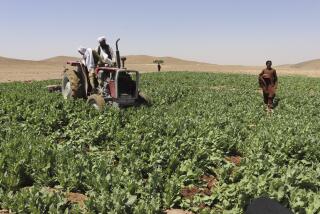Britain and U.S. Scour Mountain Hide-Outs
BAGRAM AIR BASE, Afghanistan — British Royal Marines scoured the rugged mountains of southeast Afghanistan on Friday to search out and destroy a network of hide-outs and supplies used by Taliban and Al Qaeda fighters.
The first patrols in the biggest coalition deployment in two months have yet to encounter any suspected accomplices of Osama bin Laden, Royal Marines spokesman Lt. Col. Paul Harradine said. But they have found caves and fortified positions suggesting the region is or was used by enemy forces.
“It’s only just starting. They’ll be moving through the area looking for caves, looking for bunkers, looking for Al Qaeda and Taliban,” Harradine told journalists here of Operation Snipe, an effort to cleanse a remote mountain area of forces hostile to the interim government in Kabul, the Afghan capital.
Harradine and U.S. military spokesman Army Maj. Bryan Hilferty denied that the operation, in which about 1,000 troops have been deployed to the perilous region west of the city of Khowst, was linked with a buildup of U.S. Special Forces in the tribal regions of Pakistan just across the border.
But previous campaigns have shown that Al Qaeda and Taliban forces in the mountain strongholds are able to evade each onslaught by slipping through a honeycomb of caves and tunnels, perhaps encouraging a two-pronged approach in the latest move.
During the U.S.-led assaults on Tora Bora in December and on the Shahi Kot valley in March, the Al Qaeda and Taliban forces were able to reach refuge in the anti-Western tribal region of northwestern Pakistan.
Although the exact location of Operation Snipe has been kept secret for security reasons, the mountainous area as described appears to be relatively near Shahi Kot. Harradine said a day earlier that the area of operations hadn’t been probed by coalition forces until now.
“They’ve encountered evidence of caves and historical defensive positions left there, but nothing of significance,” Harradine said of the first foot patrols in the area, which he suggested might take weeks to comb. While no clear traces of recent enemy activity or support have been uncovered, he reiterated that the operation was launched because forces here have “credible intelligence” of Al Qaeda or Taliban movements in the region.
Harradine said the mission mandate is “to clear a given area of land of Al Qaeda and any defensive bunkers, caches or anything they have in that area, then allowing forces loyal to the Afghan interim authority to take control of that region.” He was referring to the government of Prime Minister Hamid Karzai, whose ability to hold the country together ahead of next month’s convention of tribal elders to select a new leadership has come under strain from attacks by Taliban stragglers and regional warlords.
Operation Snipe is part of an extended mission, known as Operation Mountain Lion, to expunge the volatile east-central Afghan mountains of the Taliban and their Al Qaeda allies. Although Afghans in the region of Operation Snipe are often supportive of the Taliban and the movement’s fundamentalist Islamic tenets, Harradine said British troops so far have been received congenially in the villages they are searching.
“The reconnaissance forces have built up a daily pattern of normal life out there, and I contend so far that what they’ve seen is good news,” Harradine said. “That does involve people moving around with weapons, but Afghan people do carry weapons and they go about their business carrying weapons. There’s no aggressive intent being shown.”
More to Read
Sign up for Essential California
The most important California stories and recommendations in your inbox every morning.
You may occasionally receive promotional content from the Los Angeles Times.










